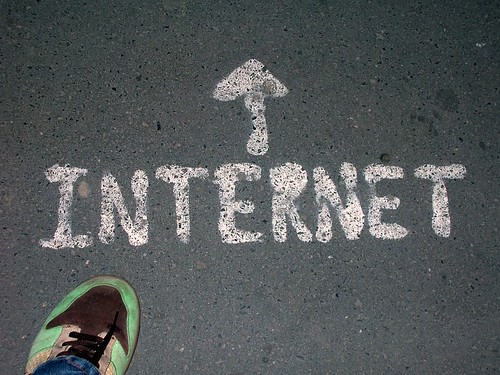Photo Backup: Online Services

photo credit: transCam
To wrap up this sub-section of the photo backup series, we'll be talking about online backup solutions. I don't personally use any of these services, so I'll be relying on my knowledgeable audience to supplement this article with their comments.
FOLLOW THIS SERIES OF ARTICLES!
TOC — PHOTO BACKUP GUIDE
BACK — DVD PHOTO BACKUP… AGAIN
NEXT — SOFTWARE
In the next article, we'll go over some software solutions for organizing and executing your backup strategy.
THE BASICS
Online file hosting services offer you the ability to upload your files (photos) to their system, while giving you the opportunity to download your stored files when needed. Some services are directly aimed at photographers, while others are more general and appeal to a wider audience.
What you're basically doing is placing your files on a hard drive connected to the web. You access that drive via a web interface (HTTP) or an FTP interface. These web-connected hard drives are typically redundant, backed up, and distributed across multiple physical locations — so you shouldn't have to worry about the host losing your files if their affairs are in order.
Some services will also allow you to use their own software for interacting with your storage space — giving you more options and features than a standard FTP interface. And most of them have some sort of web interface that you can access from any computer connected to the Internet.
BACKING UP
Backing up to most online services is quite different than backing up to a local drive. Internet connection speeds are far slower than local connections, and this may play into your backup strategy. Money may also be a factor depending on the particular service you're using — some charge for both bandwidth and storage.
The specific procedure for backing up online will be determined by the hosting service. Some are completely manual, requiring you to choose files for upload and organize uploaded files as you see fit. Others might provide you with a piece of software that automatically monitors your archives for changes and uploads the files for you.
When choosing an online backup solution, you'll want to evaluate the service for several things: supported file formats, upload methods, download methods, security measures, data redundancy, sharing capabilities, bandwidth limits, storage limits, price, revision tracking, etc.
STRENGTHS
The integrity of an online backup is probably better than any local methods — if your chosen service is good about their own backups. If a natural disaster wipes out your house, your photos will be safely stored in some other location.
Another strength of the online backup is the accessibility. You can get to your photos from just about anywhere at anytime.
Some online backup or archive services offer additional features aimed specifically at photographers. You might be able to share your photos in a gallery or even sell your photos as prints or stock.
WEAKNESSES
I think the major weakness of the online backup solution has to do with Internet access. Even the fastest Internet connections are way slower than anything right on your own computer. Plus, some Internet Service Providers will restrict your bandwidth usage, charge you extra for going over the limit, or throttle you down.
Other things you might have to worry about include the security of your photos (it is the Internet after all) and the long-term availability of your photos. I actually go hit by that last one — I signed up for a photo backup site and it ended up shutting down a few months after I got all my photos uploaded. I haven't gone back to an online backup since.
Oh yeah, and these things cost money. Most services will offer up a few GB for free, but larger accounts will cost money on a recurring basis. You'll have to evaluate if the ongoing cost is worth the extra protection.
CONCLUSIONS
Online backup solutions are still a bit sketchy in my mind. You can't know how long they'll be around for, and you're basically entrusting your important collection of photos to somebody else.
If you feel the need for an online backup, do some serious research first — don't rush into the first good looking offer. And if you're not sold on backing up all your files through an online service, a good alternative is to only backup your “good” photos online.
In the end, you have to balance the pros and cons of such services and decide if it's worth it. And, as with any backup method, don't rely on just one method — at least two different backups are recommended.
SERVICES
As I said, I don't use online backups. The sites and services listed below are some good places to start your research — I'm not recommending them in any way. Click at your own risk.
- Amazon S3
Amazon offers a reasonable rate on storage space and upload bandwidth — plus you can bet they'll be around for a few more years. - PhotoShelter Personal Archive
Geared more toward photographers, they offer good options for print and license sales… though the price is a bit higher than most. - Mozy
These guys seem to have lasted through their infancy, and they have a decent looking backup solution — fancy desktop software for keeping track of things too. - IDrive
Another service along the same lines as Mozy. - Carbonite
Again, another similar service to the last two. - KoffeePhoto
A little more photo-centric, these guys have a community built around their service. - Zenfolio
Also aimed at photographers, Zenfolio gives you good options for displaying photos and selling prints. - SmugMug
Similar to Zenfolio, offering solutions strictly for photographers. - Flickr
Flickr may not be the first thing that comes to mind for photo backup, but a pro account gives you the ability to upload unlimited full-res images — plus the Flickr community is just awesome.



Mike
December 5, 2008The (lack of) fastness and the cost would make me conclude only to backup the best of the best. Look at it as an extra backup method for when you’re house is on fire and the hard disks can’t be saved.
Anyway… my parents hold on to my backup DVD’s, just in case.
Neil Creek
December 5, 2008I think that these online backup services are almost a service ahead of their time. The limitations you mention are basically technical and reputation. It is only a matter of time before the technical matters are insignificant: exponential technology growth will soon mean ubiqutous super fast speeds and cheap as chips storage. Reputation will also sort itself out in time, as the fly-by-night operations fail and the good companies prosper and learn how to do things the right way.
Given those two problems can be solved, online backup really is the best solution.
However, I think we’re several years away from that, and the way things are right now, is such services are on the bleeding edge, and people will get cut. It’s gonna bee even longer for those of us in countries with poor broadband (like Australia, throttled at 20kbps upstream with caps and excess charges). The way things stand for me now, it’s not even an option.
But I really look forward to the day when I can upload directly from my 5DIII via high speed wireless to three seperate, redundant services simultaneously, while out in the field. It will happen!
Carl
December 5, 2008An additional word about KoffeePhoto. KoffeePhoto includes an optional software that handles all uploads in background making the upload time almost transparent. But we are not magicians, it will not upload faster… 😉
Omar
December 5, 2008I’m using BeInSync which has both an on-line backup component and the ability to sync two computers across the internet. I set it up to sync my data files to my brother’s computer and his to mine. Both of us now have real-time file backup and it’s a ten minute drive to the other house to burn a dvd if one of us loses a drive. Since I don’t have to pay for gigabytes of on-line space, it’s cheaper as well.
I use this in addition to backup software that daily does a backup to another computer in my house. The in-house backup covers me if I deleted something important. Occasionally, I burn a dvd of this in-house backup and take that off-site for archiving purposes. BeInSync is my automatic off-site initial backup.
It’s comforting to know that within hours of loading photos from a trip, they are on a second computer in the house, and automatically on another computer in another city.
Eric
December 5, 2008I’m not sure I’d inlude Flickr/Smugmug/Zenfolio as backup solutions. First, they’re meant for sharing and display, not backup – they’re not really designed to host an entire archive, just the ones you want to share. Second, they do come with limits – Flickr has a 20MB file size limit, and all of them (to my knowledge) will only host JPGs. I guess in the event of armageddon you can pull down your JPG’s from these sites, but that’s sort of like putting your photo album in the safe rather than the negatives.
(FWIW Smugmug does has smugvault, which is essentially Amazon S3 tied to your smugmug account, for RAW files).
In general I agree with the criticisms above. These services are too limited by bandwidth and costs – they’re ideal for a few gigabytes, but if you have an archive in the hundreds of gigabytes then you’re looking at months to upload everything and then quite a bit of cash to keep it there. Until consumer broadband stops being a joke, and storage costs come way down (Amazon’s $0.15/GB/month works out to $100/month at 600 GB, or the price of a brand new TB external hard drive every month).
Pity, because this would be my preferred solution. The technology just isn’t there though.
Jordan Janisse
December 5, 2008Right on! It is so important to backup your valuable content. Every day thousands of computer files are needlessly put at risk. Finding a solution that is right for you is so important.
Take care.
-Jordan.
backup.jmjgroup.com
Life is too short!
Air Jordans
December 6, 2008I’ve used Mozy but I enjoy Flickr the most because the additional benefit of getting your pictures out into the public eye.
Udi
December 6, 2008Another con for internet backups is the fact that LR uses has one big file that constantly changes – this is the catalog file. it is a few megs file that changes with each change to any of the images. Almost impossible to backup using internet backup
Jarrod Erbe
December 7, 2008I took advantage of a special offer with PhotoShelter Personal Archive when the PhotoShelter Collection closed. No complaints so far – uploading is efficient and the online gallery and pricing tools provide plenty of options. You are on you own with respect to the marketing of images on this site (as opposed to the PS Collection).
Phil Thomas
December 15, 2008Thanks for the article, this is something I have to do. I currently store on external drives but it makes me very nervous not to have them safely somewhere else. If disaster strikes and I lost my pictures I would be devastated. My solution is do online and offline.
Greg Lato
December 21, 2008Brian, I think you missed the point on this topic. While you did a good analysis with the general strengths and weaknesses of online backup, you missed the key value proposition entirely. It’s about have an off site backup of all your files, maintained in an automated way, so you can recover from worst case scenario.
If you home/studio burns down, what have you lost regarding your photography? You need to have all you data: original photos, incremental developed photos, contracts, location notes, documents safe off site. This is what online backup provides by automatically backing up everything you want in the background while you’re not working. So you don’t have to think about the backup, it’s just there.
Some of the services you mention (Flickr, Zenfolio, Carbonite), don’t backup original images or non photo files. If you shoot raw, what is the point of having your final JPGs backed up if you loose all you negatives? And if you’re running a business (even a part time side business), you need to have the photos as well as your business documents backed up.
Also, you need to keep in mind how each true online backup service works. Sometimes they don’t support files living on a NAS. Or if you try to migrate the backup from one computer to another it can cause problems. And take the time to dig a little deeper on each company; Mozy for example is wholly owned by EMC corporation, one of the largest providers of storage solutions to companies in the world.
Online backup services have been working great in Corporate America for years. If you’re willing to pay the price of the insurance, they work great. But in this case, just remember that you get what you pay for…
Brian Richards
January 2, 2009Check out Microsoft Skydrive with 25Gb of online storage for FREE.
Gavyn
May 14, 2009Mozy is nice, but doesn’t let you share your pictures publicly or privately. I’ve been using the Photo Backup services of MyOtherDrive.com. It allows me to specify the security level of photos at a folder level. I share with my clients view, but not download until the purchase the proofs and then give them download access later.